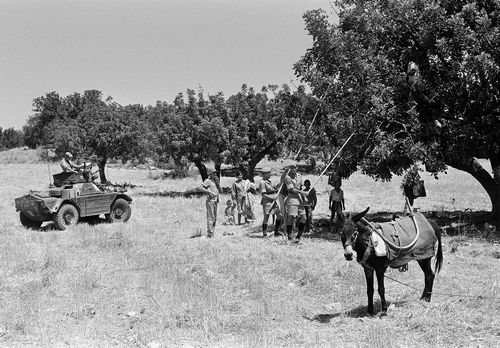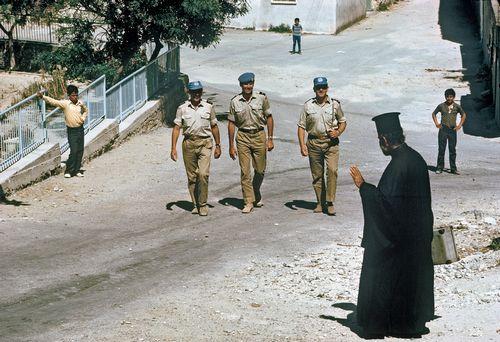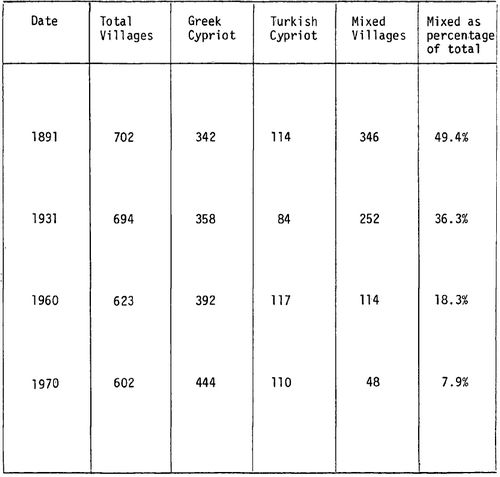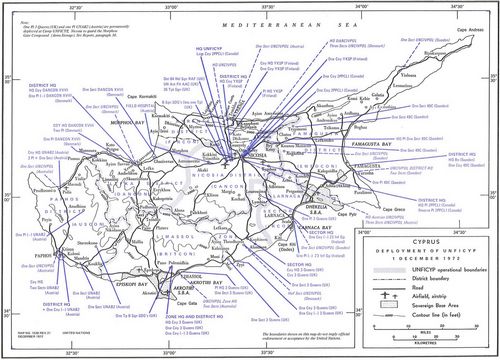The United Nations takes over.....The Calm Before the Storm
At the end of 1967 there was, "a sobering realization by both Greek and Turkish Cypriots that they had barely escaped catastrophe and that the danger was by no means past".

U Thant, the UN Secretary General and Major-General Martola, the UNFICYP commander in 1968
In the twelve months of 1968 there were 104 minor breaches of the ceasefire compared to 630 the previous year. It was felt that there were no deliberate breaches and those that had occured were accidental discharges by young and inexperienced personnel.
Additionally in 1968 the Government announced that a number of 'normalisation measures' would be applied island-wide (except the main Turkish enclave north of Nicosia). The resulting removal of the majority of roadblocks and checkpoints allowed greater freedom of movement for both communities.

British UN soldiers based in the Limassol area help local farmers harvesting their carobs.......dated September 1968
On the 8th March 1970 an attempt was made on the life of President Makarios. At about 7am, Makarios was about to travel by helicopter to Machairas Monastery where he was to lead a memorial service. As soon as the helicopter took off from the courtyard of the Archbishopric, which is located within the walled city of Nicosia, it was fired on repeatedly from the roof of the Pancyprian Gymnasium building across the street. The helicopter pilot was seriously wounded but managed to land the damaged machine in a nearby clear space. The President was uninjured. Six Greek Cypriots, among them three members of the Cyprus Police went on trial charged with conspiracy to assassinate the President and to overthrow the Government.
Such an incident created a general feeling of insecurity undermining the prevailing, generally calm atmosphere.

The helicopter carrying Makarios landed safely although the pilot (Major Zacharias Papadoyiannis) was seriously wounded in the stomach
Throughout the early 1970s the situation prevailing in Cyprus was described as, "one of negative stability, quiet on the surface but strained, abnormal and fraught with the serious danger inherent in the continuing close confrontation of well armed and trained forces. With the passing of time, this situation is threatening to become the way of life of all Cypriots, thus perpetuating the need for UNFICYP's presence in the island".

Three members of the Danish UNFICYP Civilian Police in the Greek sector of Ayios Theodoros in May 1973
The trend towards the separate development of each community was clearly observed and the number of purely Turkish Cypriot and mixed villages continued to decline. The Turkish Cypriots even began to issue their own postage stamps.

In 1964, U Thant wrote:
"Suspicion and a lack of mutual confidence dominate relations between the two communities. Constructive initiative and non-interference are inevitably and invariably misinterpreted by one side or the other".
In 1974, Kurt Waldheim wrote:
"Relations between the two communities are still marred by mutual fear and mistrust. No settlement is possible without mutual concessions and accommodations".
The following is an extract from 'A Business of Some Heat' by Brigadier Francis Henn which exemplifies the nature of both Secretary Generals' comments and the everyday role of UNFICYP.
"A Turkish Cypriot bank manager decided to build himself a house right on the Green Line. This was at a sensitive and disputed point on the Line and the National Guard protested that it was a Turkish ruse to move the Line forward and establish a military strongpoint on it. The matter gave rise to mounting tension and a threat of action by the National Guard. When the (Turkish) Leadership professed not to have the authority to halt construction UNFICYP decided to intervene. Under cover of darkness a small UN post, found by the Finns in whose operational area it lay, was deployed right on the spot where the foundations were being prepared, a UN flag was hoisted and the post was surrounded with barbed wire. When Turks turned up in the morning to resume work, they were told politely that this was a UN post (nicknamed 'Piknik 2' - a reference to a nearby restaurant) to which entry was not permitted. Both sides accepted without demur what UNFICYP had done and a potentially explosive situation had been defused"
At the start of 1974 the division of Cyprus could be described as the 'Green Line' which ran through Nicosia and a number of other 'mini-Green Lines' that observed and demarcated the two communities in towns and villages. The map below (dated 1972) shows how the UN presence was spread throughout the island.

Click this link for a larger image (opens in a new window)
Perversely, it was conflict within the Greek and Greek Cypriot communities that would write the next chapter of "The Green Line".